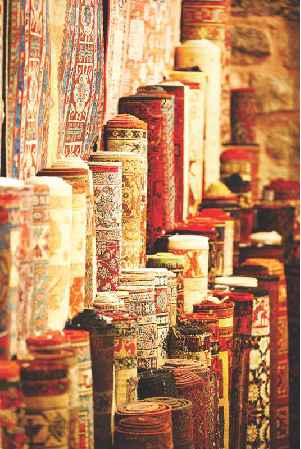Rugs Of India

Indian hand-made rugs & carpets, like folklore, are a testament to this civilization’s cultural richness. Apart from being the biggest exporter of hand-made carpets in the world, India also has a widely acknowledged tradition of carpet wearing and thriving cottage industry.
Ever since the art of carpet weaving was introduced in Kashmir in the 15th century, it has been passed on from generation to Varanasi district towns like Bhadohi, Mirzapur, Gopiganj & Sitapur; Agra; Srinagar in Kashmir, Jaipur and Bikaner in Rajasthan; Panipat in Haryana and Gwalior in Madhya Pradesh. Today, India has become a hub for different varieties of carpet weaving that mirror cultures, lifestyles and aesthetics of various countries, eras and civilization.
As a catalyst, Carpet Export Promotion Council, under the ministry of Textiles, Government of India has been playing a key role in promoting Indian hand-made carpets world-wide. It facilitates their sourcing in India for international buyers.
India continues to not only retain its leadership in global handmade carpet market, but also continues to increase its market share which today stands at a healthy 32% of world trade. Handmade carpets not only face competition from machine made ones, but also other forms of floor coverings like wooden flooring, vinyl, marbles, tiles and a variety of synthetic alternatives. There are a number of reasons why Indian handmade of carpets are surviving and thriving.
For one, discerning consumers world over increasingly prefer a more personalized, warm décor for which no materials can still beat natural wool, silk and cotton made, soft & warm, colourful handmade rugs and carpets.
Secondly, infinite, wide possibilities in Indian carpets in terms of quality, design, colours and fibre blends helps interior designers and consumers the precise look they seek, unlike the mass produced machine-made products.
Third, consumers across the globe support more sustainable, natural and eco-friendly products.
Besides, there are reasons like India is the only country where one can find carpets and rugs in cotton-jute and jute-wool mix, where you have numerous silk-blends and several combinations with wool. No wonder then, despite severe onslaught of machine made products, Indian handmade carpets will continue to be popular across the globe.
Even in the face of a slow international economic recovery. India’s carpet exports have grown by 8.7% in FY 2013-14 to reach $1175 million from $1080.9 million in FY 2012-13. While there was not any major shift in markets, aggressive efforts continued in new markets like China, Russia, Japan and Latin American countries. In these countries high import duties had discouraged entry of Indian carpets in the past.
Kilims are one of the most popular segments of the handmade carpet demand. In this segment however, the demand is increasingly shifting from woollen to cotton Kilims. Silk carpet exports grew 32% during April-September 2014 as compared to same period in previous year. Hand-knotted woolen carpets have a large variation in rates because the product quality largely depends on the quality of wool contained, which is important and also the number of knots per square inch.
The significant employment of generating well-deserving sector gets a significant support from the Government of India. The hand-made carpet sector employs 6-7 lac skilled weavers. One lakh of these are engaged in J & K workshops and an equal number in the Bhadohi-Mirzapur belt. Jaipur, Agra, Gwalior are the other major centres for hand-made carpets.
New centres of carpet weaving are coming up in India, though in a smaller way. The activity has picked up in the some of the southern states and the government is planning to support these initiatives as they offer gainful employment avenues for the rural population.
It is widely accepted by leading carpet industry experts that over the next two years the overseas market for Indian hand-made carpets will continue to grow at a good pace. Some of the major overseas buyers are now sending their designers to work closely with Indian manufactures and this is proving helpful for the industry as it inspires confidence on both sides.
CEPC organizes Indian Carpet Expo twice a year. It is now Asia’s biggest carpet show, and is one of the largest expositions of hand-made carpets in the world in terms of variety and designs of products displayed.































